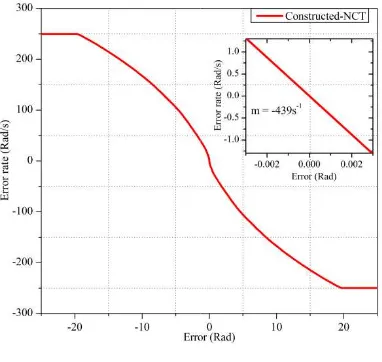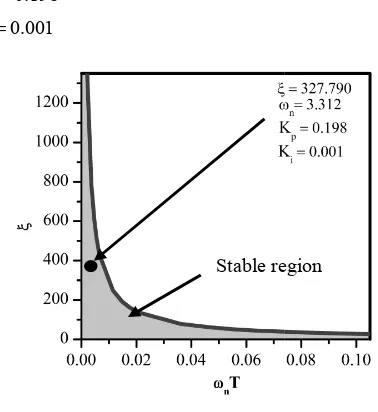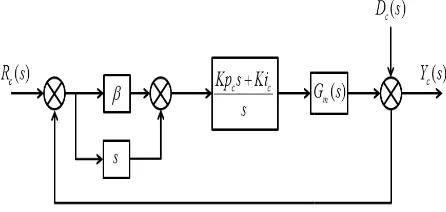1. INTRODUCTION
Point-to-point (PTP) positioning system plays an important role in industrial application such as semiconductor industries, manufacturing system, precision control and robotics. An advance machine and equipment are needed to ensure the production could possess a better product quality and quantity. For some reason, the effectiveness of the equipment may not yield a good performance because of a non-linear characteristic of positioning system. The examples of non-linear characteristics are friction, saturation and also parameter uncertainties. This behavior may affect the system performance by limited the system cycles, cause large steady state error and make the system unstable.
In order to perform the promising positioning system, many engineers or researchers have tried to improve the machine mechanism, use an advanced sensor or design a controller. All three features are important because each of them has significant influence towards the system. For some reason, the use of an advanced sensor or improve the machine mechanism may not suitable because it requires high cost and maintenances. As an alternative solution, a controller is necessary needed to demonstrate high accuracy, fast response, high speed and robust to uncertainties, parameter variations and disturbance.
Positioning system performance usually affected by nonlinear characteristics such as actuator saturation, friction and also the influences of disturbance or uncertainties. The saturation that produced by an actuator may cause the slow system performance and affect the system stability, while too much friction may cause too large steady state error and limit output cycles near the reference input. Hence, the proposed controller must be able to consider all the above-mentioned issues in the design criteria to possess a promising control
performance.
Up to date, many controllers have been proposed in order to improve positioning and continuous motion performances of a system, such as disturbance observer [1], sliding mode control [2] and time optimal control [3]. The above-mentioned controllers may demonstrate sufficient responses, however, it requires complexes design procedure. Besides, the advanced controllers require exact and accurate model parameters in the design procedure that sometimes time consuming to the researcher or engineer.
As a result, the Nominal Characteristic Trajectory Following (NCTF) controller is proposed for this research as a practical control method. Until now, the study on NCTF Controller has been done towards various types of system. In [4], the NCTF controller was first time proposed for a rotary system. Then, the NCTF controller has been proposed and examined using a ball screw mechanism for point-to-point and tracking controls [5]. In [6], the NCTF controller has been proposed to 1-DOF air slide non-contact mechanism and it was proved that the NCTF control design procedures is independent of friction characteristic. In this paper, the Continuous Motion NCTF (CM NCTF) controller is proposed for the positioning and tracking control of a rotary system.
The CM NCTF controller is an improved NCTF control system for tracking and contouring motions. The CM NCTF control performance is applied to a one mass rotary system, and its motion control performance is evaluated from the experimental tracking and positioning control results.
2. CONTROLLER DESIGN
2.1 Continuous Motion (CM) NCTF control system The CM NCTF controller is comprised of Nominal
Robustness Evaluation for Point-to-Point Positioning Control of A One Mass Rotary System
Rozilawati Mohd Nor
1and Chong Shin-Horng
2*1
Centre of Excellence of Robotics and Automations,
Universiti Teknikal Malaysia Melaka, Malaysia ([email protected]) 2
Faculty of Electrical Engineering, Universiti Teknikal Malaysia Melaka, Malaysia. ([email protected]* )
Abstract: In this paper, the Continuous Motion (CM) NCTF controller is proposed for a point-to-point (PTP) positioning system of a one mass rotary system. For this system, the CM-NCTF controller is designed based on the conventional structure of NCTF controller and improved. The CM-NCTF controller consists of Nominal Characteristic Trajectory (NCT) and Proportional Integral (PI) compensator. It is designed without knowing exact system modeling and parameter evaluation. The NCT is constructed from open loop responses while the PI compensator is designed based on the constructed-NCT itself. The effectiveness of the CM NCTF controller is evaluated and compared with the PID controller for positioning and tracking motion performances experimentally. The robustness of the CM NCTF controller is validated by varying the mass load. Overall, the CM-NCTF controller demonstrates promising positioning and tracking performances, and low sensitivity towards the change of mass load in comparison with the PID controller.
Keywords: CM NCTF; PID; Positioning control; Tracking control; Sensitivity
Characteristic Trajectory (NCT) and The design procedure of the CM N remains similar as the conventional system. The NCT is constructed by responses during open loop experim compensator is designed so that it is ab object motion to follow NCT and finish
The NCT is constructed on pha velocity and displacement of the system deceleration in open loop. After N constructed, the PI compensator is de the stability of the system. Fig. 1 show controller structure and Eq. 1 shows th the CM NCTF controller.
Fig. 1 Structure of the Continuous Mot control system The control laws for CM NCTF contro Eq.(1):
( )
(
i)
( )
p p
K
U s
K
U
s
s
=
+
where,
( )
( )
( )
p virtual actual
U
s
=
E s
−
E s
( )
r( )
( )
E s
=
θ
s
−
θ
s
( )
( )
virtual( )
N e
=
E s
=
β
×
E s
( ( ))
( )
virtuald
s
E s
dt
θ
=
From the Eq. (1), the
U
p( )
s
comparing the virtual error rate and a The value of
U
p( )
s
is equal to zero motion is completely following the NC constructed.2.2 Design procedure
They are a few steps to design controller. The design procedures of controller are as below:
PI compensator. NCTF controller l NCTF control using the object ment and the PI ble to control the hing at the origin.
ase plane using m motion during NCT has been esigned based on ws the CM NCTF e control laws of
tion (CM) NCTF
ller are shown in
(1)
is obtained by actual error rate.
when the object CT that has been
the CM NCTF the CM NCTF
a) System open loop respo by a stepwise open-loop inpu velocity responses are measu must not exceed the rated inp the mechanism from damag input signal is 10V and duty shows the open loop respo open-loop results will be used
Fig. 2 Open-loop b) Construct NCT: The d result obtained from open lo construct the NCT. It is co deceleration phase of displac shows the constructed-NCT w of NCT, β is 439 s-1.
Fig. 3 Constru c) PI Compensator designs with the NCTF controller us element. The proportional ga sufficient ultimate proportion (Ku) is obtained when sust
during steady state condition. an important role to make su and follow NCT precisely. On the phase plane, th divided into reaching phas During reaching phase, the P
nse: The system is driven ut and its displacement and ured. The input amplitude put of the system to avoid ed. The amplitude of the cycle (t1) is 0.5sec. Fig. 3 onse result. The obtained d to construct NCT.
system result.
displacement and velocity oop experiment is used to onstructed by using only ement and velocity. Fig. 3 with inclination near origin
ucted NCT
: The mechanism is driven sing only the proportional ain is increased to get the al gain (Ku). The sufficient
ain periodic output yield The PI compensator plays ure object motion to reach he object motion can be
the PI compensator needs to control the follow the NCT and ends at its origin the following phase.
Hence to design the PI compensator the PI gains must be under the stable re stability limit. The PI gain is selected fr stability limit (see Fig. 4) to ensure t promising performance. From the sta value of PI compensator gains are:
0.198
0.001 p
i
K K
= =
Fig. 4 System stability
3. EXPERIMENTAL RE
3.1 Experimental setup
The one mass rotary mechanism is servo motor as shown in Fig. 5. The fee determined by an incremental rotar resolution 500 counts per revolution. T of the dc servo motor is ±10V and the 2ms. This system is suitable to use a implicate the real machine used i positioning performance.
Two types of motion control perfor tracking and positioning per experimentally examined. The effectiv NCTF controller is evaluated in compa controller.
3.2 Positioning control
To evaluate the point-to-point (PTP the system, the positioning control expe done. The experiment was done usin amplitudes: 0.5-rad, 1-rad, 1.5-rad and shows the controller parameter used control of a one mass rotary system. Fig Stable re
object motion to which known as r, the selection of egion of practical from the practical the system has a ability limit, the
SULT
s driven by a dc edback position is ry encoder with The rated voltage
sampling time is as a test bed to in industry for
rmances that is, rformance are
eness of the CM arison with a PID
) performance of eriment has been ng four different
d 2-rad. Table 1 for positioning gs. 6~9 show the
Fig. 5 One mass rotar Table 1 Contro Controller β s-1 Kp
CM NCTF 439 1.98 1× PID - 12 For the positioning contro showed that the CM NCTF positioning response as comp The PID controller has a fas NCTF controller but it produ From the experiment result, produces less 30% error tha 0.5-rad input. Similar positio for the rest of input a experimental results indicate demonstrates larger position NCTF controller.
Fig. 6 Experimental respons egion
ry system structure oller parameters
p Ki Kd
1
10− 3
1 10−
× 0
2 1
5 10−
× 1
1.5 10−
×
ol experiment, it is clearly controller produces better pared to the PID controller. ster rise time than the CM uces poor result in term of the CM NCTF controller an the PID controller for oning results are obtained amplitudes. Overall, the
e that the PID controller ning error than the CM
3.3 Tracking control
For tracking control, to evaluate the controller’s performance two different amplitudes and two different frequencies for sine wave input is used. Fig. 10 and 11 show tracking control performance for frequency 0.3 Hz and amplitude 0.5 and 1.5 radian. Fig. 12 and 13 show the tracking control results for frequency 0.7 Hz and amplitude 0.5 and 1.5 radian.
Fig. 10 Experiment tracking result using 0.3 Hz frequency and 0.5 radian amplitude
Fig. 11 Experiment tracking result using 0.3 Hz frequency and 1.5 radian amplitude
Fig. 12 Experiment tracking result using 0.7 Hz frequency and 0.5 radian amplitude
From the results, the CM NCTF controller demonstrates better tracking performance by showing less tracking error as compared to the PID controller. Table 2 shows the tracking performance results for amplitude input at 0.3 and 0.7-Hz.
Fig. 13 Experiment tracking result u frequency and 1.5 radian amp Table 2 Tracking control perf
At smaller input and lower frequ controller produces 149% larger error controller. Besides, for large input and h CM-NCTF controller also produce less the PID controller as much as 49%. It that, the CM-NCTF controller gives t performance and robust to parameter v PID controller.
4. ROBUSTNESS
To evaluate the controller robustness rejection of CM-NCTF and PID contro Fig. 14 and 15 show the block diagram controller and PID controller.
Fig. 14 CM-NCTF controller bloc
Parameter Controll
CM-NCT Frequency
(Hz) 0.3
Amplitude
(Rad) 0.5 1.5 0
Error (Rad) 0.04 0.04 0 PID Frequency
(Hz) 0.3
Amplitude
(Rad) 0.5 1.5 0
Error (Rad) 0.10 0.10 0
using 0.7 Hz plitude formances
uency, the PID than CM-NCTF higher frequency, error compare to is clearly shown the best tracking variation than the
s, the disturbance oller is addressed. m for both NCTF
ck diagram
From the block diagram, the system transfer function From the diagram, the characteristics are expressed function. In order to get a b performance, the sensitivity f must be low [8] . Eq. 2 shows CM-NCTF controller while E function of PID controller.
4 3 4 3 ( ) ( ) ( ( ) CM CM CM
JLs JR bL s S
JLs JR bL s bR
KKp KKi s
β β + + + = + + + + + + 4 3 3 2 ( ) ( ( ( ) PID PI PID
JLs JR bL s bR S
JLs JR bL KKd
bR K KKp s K
+ + +
=
+ + +
+ + +
Hence, the sensitivity of bot Eg.4 below.
( )
CM PID PID
PID CM CM CM
S Kp Ki
S βKp Ki s Kp
+ =
+ +
From Eq. 9, the sensitivity controller is able to produce PID controller. SO, it can be controller provides highe characteristic than the PID con
5. CONCL
For the conclusion, for control experiment, CM-NCT better response of all. For P bad positioning and trackin large overshoot during posit error during tracking per disturbance rejection charact that CM-NCTF controller p result. This indicate that the C higher disturbance rejection PID controller. er TF 0.7 0.5 1.5 0.03 0.08 0.7 0.5 1.5 0.08 0.12
the
G s
m( )
represent by n of the DC servo motor. e disturbance rejection d as following sensitivity better disturbance rejectionfunction of the closed loop s the sensitivity function of Eq.3 shows the sensitivity
2 2 2 2 ( ) ) CM CM
bR K s
K KKp s
KKi β + + + + (2) 2 2 2 ) ) PID PID K s s KKi + + (3)
th controllers is shown in
M+βKiCM
(4)
function of the CM-NCTF es less magnitude than the e conclude that CM-NCTF r disturbance rejection ntroller.
LUSION
REFERENCES
[1] Y.-D. Yoon, E. Jung, and S.-K. Sul, "Application of a disturbance observer for a relative position control system," Industry Applications, IEEE Transactions on, vol. 46, pp. 849-856, 2010. [2] L. Huibo, W. Yun jie, and Z. Jipeng, "PID sliding
mode control based on disturbance observer," in
Control and Decision Conference (CCDC), 2011 Chinese, 2011, pp. 1278-1281.
[3] R. Shieh and L. Yu-Sheng, "Jerk-constrained time-optimal control of a positioning servo," in
Control Automation and Systems (ICCAS), 2010 International Conference on, 2010, pp. 1473-1476. [4] K. Sato and A. Shimokohbe, "Characteristics of
practical control for point-to-point (PTP) positioning systems: Effect of design parameters and actuator saturation on positioning
performance," Precision Engineering, vol. 27, pp. 157-169, 2003.
[5] G. J. Maeda and K. Sato, "Practical control method for ultra-precision positioning using a ballscrew mechanism," Precision Engineering, vol. 32, pp. 309-318, 2008.
[6] S.-H. Chong and K. Sato, "Practical controller design for precision positioning, independent of friction characteristic," Precision Engineering, vol. 34, pp. 286-300, 2010.
[7] Rozilawati Mohd Nor and C. S. Horng,
"Continuous Motion NCTF Control of a One Mass Rotary System," International Electrical,
Electronics, Control & Instrumentation
Engineering (IEECIE) Journal Proceedings, vol. 2, pp. 316-321, August 27-28,2013 2013.
[8] Sigurd Skogestad and I. Postlethwaite,


